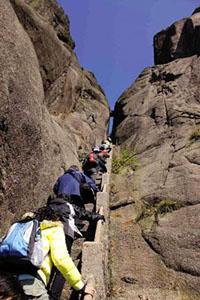Introduction to
Huangshan and Huangshan City
Huangshan City is a region with a long history and splendid culture.
Shexian and Yixian Counties were established more than 2,000 years
ago. In the Jin Dynasty (265-420) Huangshan City was called Xin'an
Shire. Until the Song Dynasty (960-1279) when the name was changed
to Huizhou, the city was famed for Hui businessmen, Hui carvings,
Xin'an school of painting, Xin'an medicine, Hui architecture, Hui
cuisine, and Hui opera (one of the tonalities of Beijing Opera).
Also notable are the scenic spots of Yellow Mountain (Mt. Huangshan)
- a key point of interest in ancient China, the Tangyue Memorial
Archway, the Tunxi Ancient Street and the ancient villages of Yixian
County . Historians at home and abroad regard Huangshan City as a
natural history and culture museum of China.
 Since Huangshan City is a tourist city with a pleasant climate,
travel plans need not be interrupted by weather. So the sights of
Huangshan City, such as Tunxi Ancient Street, Xidi, and Hongcun
Ancient Villages, Tangyue Archways, Flower Mountain and Enigma Caves
can be visited throughout the year as can Yellow Mountain with each
season offering different appealing features. Since Huangshan City is a tourist city with a pleasant climate,
travel plans need not be interrupted by weather. So the sights of
Huangshan City, such as Tunxi Ancient Street, Xidi, and Hongcun
Ancient Villages, Tangyue Archways, Flower Mountain and Enigma Caves
can be visited throughout the year as can Yellow Mountain with each
season offering different appealing features.
Tunxi Ancient Street, HuangshanHuangshan City transportation is
efficient. Upgraded airline, railway, highway and the city
transportation expedite tour travel. Also available are various
grades of hotels, restaurants, and recreation and shopping centers
in Huangshan City. Be sure to try Hui dishes, snacks and local
products and especially the memorable Mt. Huangshan tea.
Yellow Mountain (Huangshan mountain)
Of all the notable mountains in China, Yellow Mountain (Mt.
Huangshan), to be found in the south of Anhui province, is probably
the most famous. Originally known as Mt. Yishan it was renamed Mt.
Huangshan in 747 AD in recognition of the legendary Huang Di, who
was the reputed ancestor of the Chinese people and who made magic
pills for immortality here.
Wu yue is the collective name given to China's most important
mountains, namely Mt. Taishan in Shandong Province, Mt. Huashan in
Shaanxi Province, Mt. Hengshan in Shanxi Province, Mt. Songshan in
Henan Province and Mt. Hengshan in Hunan Province. It is said that
you won't want to visit any other mountains after seeing wu yue but
you won't wish to see even wu yue after returning from Yellow
Mountain. This saying may give you some idea of the beauty and
uniqueness of Yellow Mountain. Together with the Yellow River, the
Yangtze River and the Great Wall, Yellow Mountain has become one of
the great symbols of China.
Yellow Mountain can boast not only of its magnificence but also its
abundant resources and great variety of zoological species, for
which it has been listed as a World Natural and Cultural Heritage
Site.
The best east-facing viewing areas are Dawn Pavilion, Refreshing
Platform, Lion Peak, Rosy Clouds Peak, Bright Peak Summit, Jade
Screen Peak, Lotus Blossom Peak and Heavenly Capital Peak; best
times to view a sunrise:
Spring ---- 05:30-06:00
Summer ---- 04:40-05:10
Fall ---- 04:50-05:20
Winter ---- 05:30-06:00
Best times and viewing areas from which to see sunglow on Yellow
Mountain:
Before and after sunrise is the best time to see sunglow. As with
viewing the sunrise, you should be in position early.
Best times and viewing areas from which to see seas of clouds on
Yellow Mountain:
From September to May is the best season for cloud viewing,
especially on a clear day after rainy or snowy weather. Seas of
clouds are infrequent in summer. To best experience the beauty of
seas clouds, tourists should change their viewing locations points
according to the height of clouds.
Huangshan City Tourist Attractions:
Tunxi Ancient
street Xidi and
Hongcun Ancient Villages Shexian County Ancestral Temples
Ancient
Residential Houses Mt. Jiuhua Tangyue
Memorial Archways Town of Arches |

